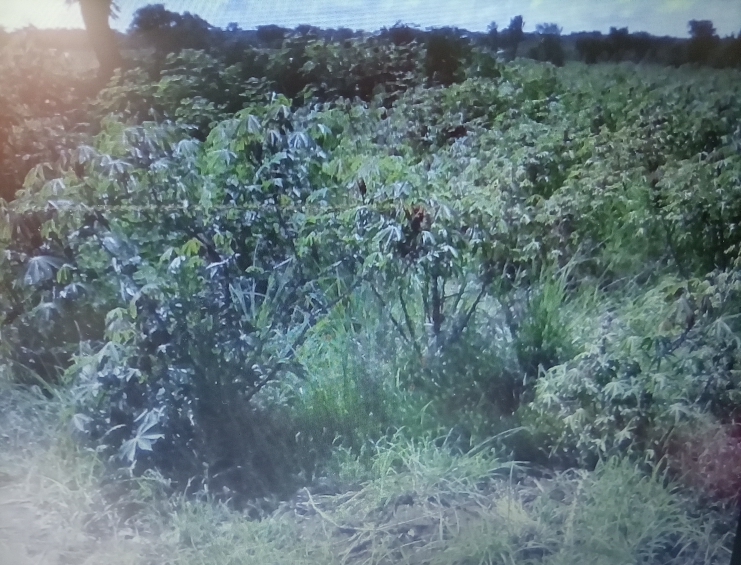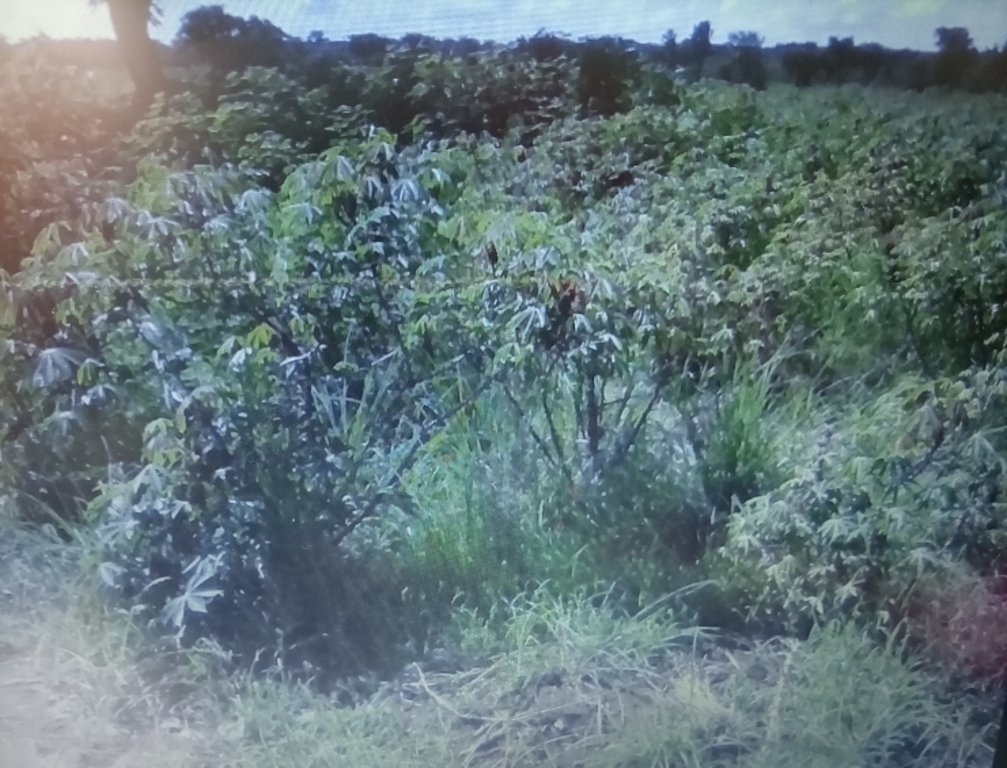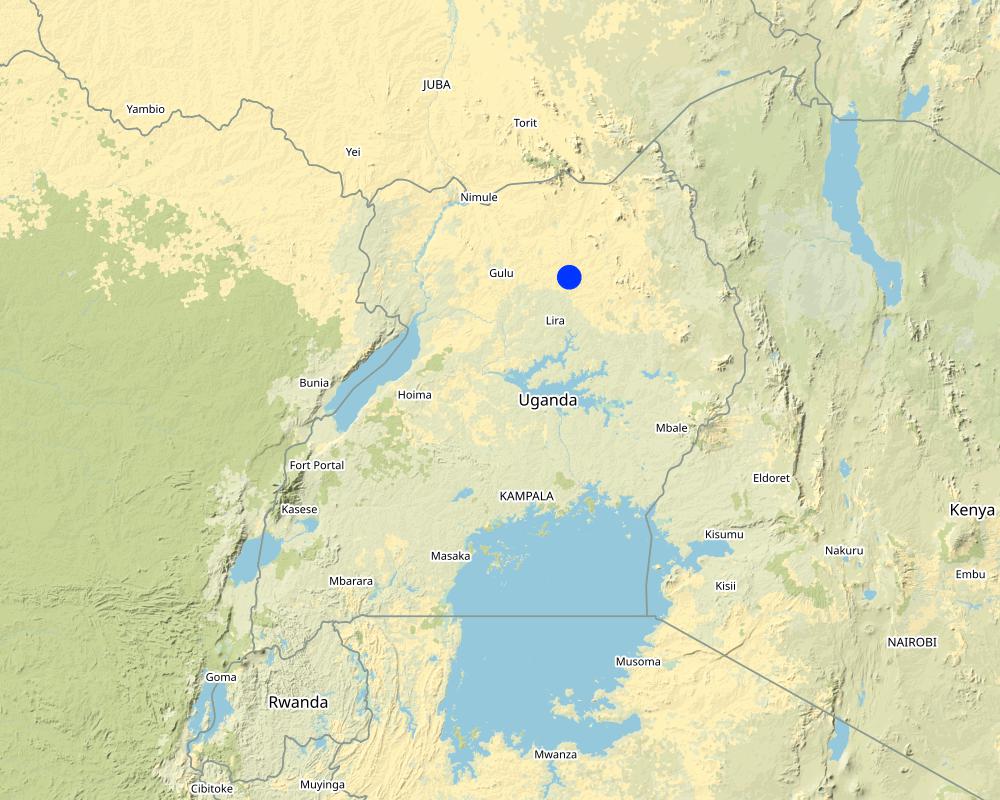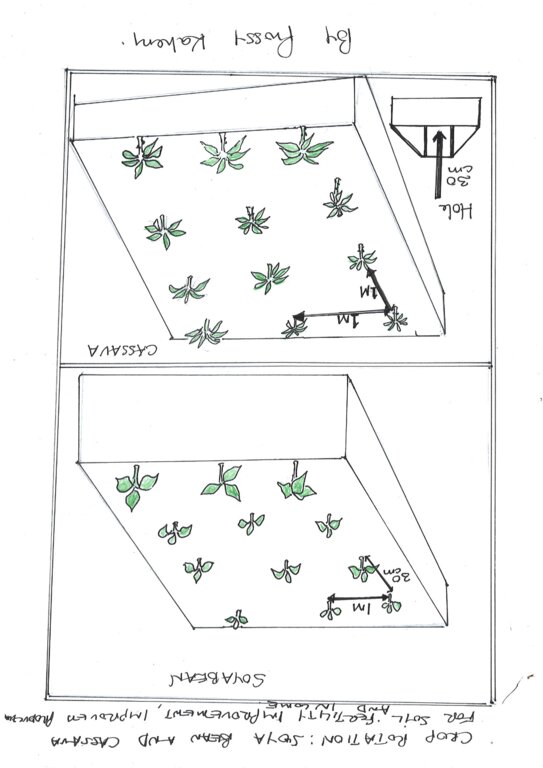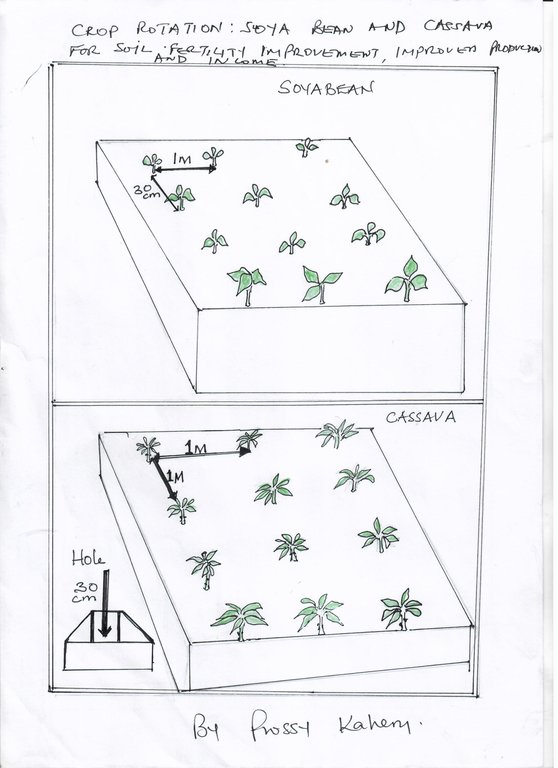Cassava-Soybean Crop Rotation for Soil Fertility Improvement, Improved Production, Income and Food Security [Uganda]
- Creation:
- Update:
- Compiler: betty adoch
- Editors: JOY TUKAHIRWA, Kamugisha Rick Nelson, Bernard Fungo
- Reviewers: Drake Mubiru, Nicole Harari, Stephanie Jaquet, Udo Höggel
Leno cam i poto
technologies_2707 - Uganda
View sections
Expand all Collapse all1. General information
1.2 Contact details of resource persons and institutions involved in the assessment and documentation of the Technology
Key resource person(s)
land user:
Olal Levi
Agago District Local government
Arum village, Kazikazi Parish, Kazikazi Sub-County, Agago District.
Uganda
Name of project which facilitated the documentation/ evaluation of the Technology (if relevant)
Scaling-up SLM practices by smallholder farmers (IFAD)Name of the institution(s) which facilitated the documentation/ evaluation of the Technology (if relevant)
Uganda Landcare Network (ULN) - Uganda1.3 Conditions regarding the use of data documented through WOCAT
When were the data compiled (in the field)?
10/05/2017
The compiler and key resource person(s) accept the conditions regarding the use of data documented through WOCAT:
Yes
1.4 Declaration on sustainability of the described Technology
Is the Technology described here problematic with regard to land degradation, so that it cannot be declared a sustainable land management technology?
No
Comments:
Crop rotation enhances soil fertility due to its ability to maintain plant nutrients.
2. Description of the SLM Technology
2.1 Short description of the Technology
Definition of the Technology:
Crop rotation is a common practice used by farmers in northern Uganda. It involves the growing a series of different types of crops in the same field in sequential seasons to improve soil fertility, nutrition, income and food security .
2.2 Detailed description of the Technology
Description:
With crop rotation, a crop that leaches the soil of one kind of nutrient is followed during the next growing season by a another crop that returns that nutrient to the soil or draws a different ratio of nutrients.
At the start of the season, soybean was planted on a gently sloping land in rows in a spacing of 1 meter between the rows and 30 cm between the plants. In the subsubsequent year, cassava tuber stems were cut at a length of 30 cm and planted in a hole of 30 cm depth and a spacing of 1 meter using the following required in puts: seed, hired labour, tractor, ox-plough, hoes and pangas (axes). This technology integrated as well the construction of trenches within the field for soil and water conservation.
The application of this technology increased crop yields as evidenced by the land user. Crop rotation mitigates as well the build up of pathogens and pests that often occur when one species is continuously cropped in the same location. Crop rotation improves soil structure and fertility by increasing subsoil biomass from various root structures. While promoting this practice, its important that the landuser plants as well legumes for nitrogen fixation after cropping a nitrogen depleting crop. Similarly, a low residue crop (i.e. a crop with low biomass) should be followed by a high biomass crop, like a mixture of grasses and legumes.
The application of this technology requires the land user to subdivide the land into different portions for different crops. Crops could be planted in the following manner: 1) Cereals crop with legumes, 2) Deep rooted with shallow rooted and a cover crop.
Important to note is that crop rotation is good at preventing soil depletion, maintaining soil fertility, reducing soil erosion, controlling insect/mite pests, reducing reliance on synthetic chemicals, reducing the pests' build-up and controlling weeds. On the other hand, crop rotation can be dangerous and may affect a following crop with diseases originating from the first crop.
2.3 Photos of the Technology
2.4 Videos of the Technology
Comments, short description:
Video showing crop rotation farming systems of cassava planted with soybeans.
Date:
10/05/2017
Location:
Agago Sub County Headquarters
Name of videographer:
Betty Adoch
2.5 Country/ region/ locations where the Technology has been applied and which are covered by this assessment
Country:
Uganda
Region/ State/ Province:
Agago District , Arum Sub-county, Kazikazi Parish , Arum Village.
Further specification of location:
Town council
Comments:
The GPS coordinates shows the cassava field described in Agago District.
Map
×2.6 Date of implementation
Indicate year of implementation:
2015
2.7 Introduction of the Technology
Specify how the Technology was introduced:
- through land users' innovation
Comments (type of project, etc.):
The cassava stems were obtained from Agago District Local Government supplied by Operation Wealth Creation (OWC).
3. Classification of the SLM Technology
3.1 Main purpose(s) of the Technology
- improve production
- reduce, prevent, restore land degradation
- adapt to climate change/ extremes and its impacts
- create beneficial economic impact
3.2 Current land use type(s) where the Technology is applied

Cropland
- Perennial (non-woody) cropping
Main crops (cash and food crops):
Cassava and soybean
If land use has changed due to the implementation of the Technology, indicate land use before implementation of the Technology:
It was originally uncultivated land.
3.3 Further information about land use
Water supply for the land on which the Technology is applied:
- rainfed
Number of growing seasons per year:
- 1
Specify:
Mostly cultivated during the wet season
3.4 SLM group to which the Technology belongs
- rotational systems (crop rotation, fallows, shifting cultivation)
- integrated soil fertility management
3.5 Spread of the Technology
Specify the spread of the Technology:
- evenly spread over an area
If the Technology is evenly spread over an area, indicate approximate area covered:
- 0.1-1 km2
3.6 SLM measures comprising the Technology

agronomic measures
- A2: Organic matter/ soil fertility
- A5: Seed management, improved varieties
3.7 Main types of land degradation addressed by the Technology

soil erosion by water
- Wt: loss of topsoil/ surface erosion
- Wg: gully erosion/ gullying

soil erosion by wind
- Et: loss of topsoil
- Ed: deflation and deposition
3.8 Prevention, reduction, or restoration of land degradation
Specify the goal of the Technology with regard to land degradation:
- prevent land degradation
- reduce land degradation
4. Technical specifications, implementation activities, inputs, and costs
4.1 Technical drawing of the Technology
Author:
Betty Adoch
Date:
10/05/2017
4.2 Technical specifications/ explanations of technical drawing
Soybean was been planted on gentlly sloping land in rows in a spacing of 1 meter between the rows and 30 cm between the plants. In the subsubsequent year, cassava was planted. The tuber stems were cut at a length of 30 cm and planted in a hole of 30 cm depth and a spacing of 1 x 1 meter integrated with trenches for soil and water conservation.
4.3 General information regarding the calculation of inputs and costs
Specify how costs and inputs were calculated:
- per Technology area
Indicate size and area unit:
43 acres
other/ national currency (specify):
UGX
Indicate exchange rate from USD to local currency (if relevant): 1 USD =:
3500.0
Indicate average wage cost of hired labour per day:
2500shs
4.4 Establishment activities
| Activity | Type of measure | Timing | |
|---|---|---|---|
| 1. | Acquiring cassava stems from Operation Wealth Creation | Agronomic | March |
| 2. | Clearing the land by tractor | Agronomic | Late March |
| 3. | Planting using hired labour | Agronomic | Early april |
4.5 Costs and inputs needed for establishment
| Specify input | Unit | Quantity | Costs per Unit | Total costs per input | % of costs borne by land users | |
|---|---|---|---|---|---|---|
| Labour | Hired labour | acres | 10.0 | 2500.0 | 25000.0 | 100.0 |
| Equipment | Tractor | pice | 1.0 | 70000.0 | 70000.0 | 100.0 |
| Equipment | Ox-plough | pice | 1.0 | 17000.0 | 17000.0 | 100.0 |
| Equipment | Axes | pieces | 2.0 | 7000.0 | 14000.0 | 100.0 |
| Equipment | Pangas | pices | 2.0 | 10000.0 | 20000.0 | 100.0 |
| Equipment | Hoes | pieces | 5.0 | 10000.0 | 50000.0 | 100.0 |
| Plant material | Seeds | 1 | 100.0 | 5000.0 | 500000.0 | 100.0 |
| Total costs for establishment of the Technology | 696000.0 | |||||
4.6 Maintenance/ recurrent activities
| Activity | Type of measure | Timing/ frequency | |
|---|---|---|---|
| 1. | Weeding | Agronomic | May |
| 2. | Establishing a fireline | Agronomic | December |
Comments:
There exists a risk of fire outbreaks in cassava cultivations.
4.7 Costs and inputs needed for maintenance/ recurrent activities (per year)
| Specify input | Unit | Quantity | Costs per Unit | Total costs per input | % of costs borne by land users | |
|---|---|---|---|---|---|---|
| Labour | Mans days for weeding for one month | 1 | 30.0 | 5000.0 | 150000.0 | 100.0 |
| Equipment | Hoe | Piece | 5.0 | 12000.0 | 60000.0 | 100.0 |
| Total costs for maintenance of the Technology | 210000.0 | |||||
If land user bore less than 100% of costs, indicate who covered the remaining costs:
no one
4.8 Most important factors affecting the costs
Describe the most determinate factors affecting the costs:
Seeds, tractor and labour hire.
5. Natural and human environment
5.1 Climate
Annual rainfall
- < 250 mm
- 251-500 mm
- 501-750 mm
- 751-1,000 mm
- 1,001-1,500 mm
- 1,501-2,000 mm
- 2,001-3,000 mm
- 3,001-4,000 mm
- > 4,000 mm
Specifications/ comments on rainfall:
Moderate rain during wet seasons from April to November.
Indicate the name of the reference meteorological station considered:
Kitgum weather station
Agro-climatic zone
- sub-humid
Tropical savanna climate
5.2 Topography
Slopes on average:
- flat (0-2%)
- gentle (3-5%)
- moderate (6-10%)
- rolling (11-15%)
- hilly (16-30%)
- steep (31-60%)
- very steep (>60%)
Landforms:
- plateau/plains
- ridges
- mountain slopes
- hill slopes
- footslopes
- valley floors
Altitudinal zone:
- 0-100 m a.s.l.
- 101-500 m a.s.l.
- 501-1,000 m a.s.l.
- 1,001-1,500 m a.s.l.
- 1,501-2,000 m a.s.l.
- 2,001-2,500 m a.s.l.
- 2,501-3,000 m a.s.l.
- 3,001-4,000 m a.s.l.
- > 4,000 m a.s.l.
Indicate if the Technology is specifically applied in:
- not relevant
Comments and further specifications on topography:
Generally flat landscape.
5.3 Soils
Soil depth on average:
- very shallow (0-20 cm)
- shallow (21-50 cm)
- moderately deep (51-80 cm)
- deep (81-120 cm)
- very deep (> 120 cm)
Soil texture (topsoil):
- medium (loamy, silty)
Soil texture (> 20 cm below surface):
- medium (loamy, silty)
Topsoil organic matter:
- medium (1-3%)
5.4 Water availability and quality
Ground water table:
5-50 m
Availability of surface water:
good
Water quality (untreated):
good drinking water
Is water salinity a problem?
No
Is flooding of the area occurring?
No
5.5 Biodiversity
Species diversity:
- high
Habitat diversity:
- high
5.6 Characteristics of land users applying the Technology
Sedentary or nomadic:
- Sedentary
Market orientation of production system:
- mixed (subsistence/ commercial
Off-farm income:
- 10-50% of all income
Relative level of wealth:
- average
Individuals or groups:
- individual/ household
Level of mechanization:
- manual work
- animal traction
Gender:
- women
- men
Age of land users:
- middle-aged
- elderly
5.7 Average area of land owned or leased by land users applying the Technology
- < 0.5 ha
- 0.5-1 ha
- 1-2 ha
- 2-5 ha
- 5-15 ha
- 15-50 ha
- 50-100 ha
- 100-500 ha
- 500-1,000 ha
- 1,000-10,000 ha
- > 10,000 ha
Is this considered small-, medium- or large-scale (referring to local context)?
- medium-scale
5.8 Land ownership, land use rights, and water use rights
Land ownership:
- individual, not titled
Land use rights:
- individual
Water use rights:
- communal (organized)
5.9 Access to services and infrastructure
health:
- poor
- moderate
- good
education:
- poor
- moderate
- good
technical assistance:
- poor
- moderate
- good
employment (e.g. off-farm):
- poor
- moderate
- good
markets:
- poor
- moderate
- good
energy:
- poor
- moderate
- good
roads and transport:
- poor
- moderate
- good
drinking water and sanitation:
- poor
- moderate
- good
financial services:
- poor
- moderate
- good
6. Impacts and concluding statements
6.1 On-site impacts the Technology has shown
Socio-economic impacts
Production
crop production
Comments/ specify:
Improved yields of cassava crop
crop quality
Comments/ specify:
Quality cassava tubers harvested due to abundant plant nutrients through crop rotation
Income and costs
expenses on agricultural inputs
Comments/ specify:
Reduced expenses through crop rotation e.g. savings on mineral fertiliser due to the integration of legumes into the crop rotation system.
farm income
Comments/ specify:
High income earned after sale of quality cassava obtained through crop rotation.
diversity of income sources
Quantity before SLM:
low
Quantity after SLM:
high
Comments/ specify:
various sources of income
Socio-cultural impacts
food security/ self-sufficiency
Comments/ specify:
Crop rotation increases cassava yield which improves food security.
SLM/ land degradation knowledge
Comments/ specify:
Good knowledge of crop rotation.
Ecological impacts
Water cycle/ runoff
harvesting/ collection of water
Comments/ specify:
Surface run-off controlled through active water collection measures.
Soil
nutrient cycling/ recharge
Comments/ specify:
Crop rotation recycles plant nutrients into the soil.
Biodiversity: vegetation, animals
pest/ disease control
Comments/ specify:
crop rotation controls the spread of pests and diseases
6.3 Exposure and sensitivity of the Technology to gradual climate change and climate-related extremes/ disasters (as perceived by land users)
Gradual climate change
Gradual climate change
| Season | Type of climatic change/ extreme | How does the Technology cope with it? | |
|---|---|---|---|
| annual temperature | increase | moderately | |
| seasonal temperature | wet/ rainy season | increase | moderately |
| annual rainfall | decrease | moderately | |
| seasonal rainfall | wet/ rainy season | decrease | moderately |
Climate-related extremes (disasters)
Meteorological disasters
| How does the Technology cope with it? | |
|---|---|
| local rainstorm | moderately |
| local hailstorm | moderately |
6.4 Cost-benefit analysis
How do the benefits compare with the establishment costs (from land users’ perspective)?
Short-term returns:
positive
Long-term returns:
positive
How do the benefits compare with the maintenance/ recurrent costs (from land users' perspective)?
Short-term returns:
positive
Long-term returns:
positive
6.5 Adoption of the Technology
- 10-50%
If available, quantify (no. of households and/ or area covered):
10 household
Of all those who have adopted the Technology, how many have did so spontaneously, i.e. without receiving any material incentives/ payments?
- 50-90%
6.6 Adaptation
Has the Technology been modified recently to adapt to changing conditions?
Yes
If yes, indicate to which changing conditions it was adapted:
- climatic change/ extremes
Specify adaptation of the Technology (design, material/ species, etc.):
Crop rotation spectrum increased through incorporating maize into the rotation system.
6.7 Strengths/ advantages/ opportunities of the Technology
| Strengths/ advantages/ opportunities in the land user’s view |
|---|
| Helps in controlling weeds thus improving productivity. |
| Good at providing income after sale of two crops. |
| Enhances maximum nutrients utilization. |
| Strengths/ advantages/ opportunities in the compiler’s or other key resource person’s view |
|---|
| Good at preventing depletion of nutrients hence, maintaining soil fertility. |
| Reduces soil erosion. |
| Reduces pest build-up therefore, reduces disease infestation. |
| Improves productivity and enhances maximum nutrients utilization. |
6.8 Weaknesses/ disadvantages/ risks of the Technology and ways of overcoming them
| Weaknesses/ disadvantages/ risks in the land user’s view | How can they be overcome? |
|---|---|
| The fungi and pests left behind from the a previous crop can potentially harm the new crop. | Liase with agronomist for advice on appropriate pesticides and fungicides to use. |
| More time is required in preparing fields for crop ahead of rotation. | Proper timing of farm operations in preparation of rotations. |
| Weaknesses/ disadvantages/ risks in the compiler’s or other key resource person’s view | How can they be overcome? |
|---|---|
| The fungi and pests left behind from the a previous crop can potentially harm the new crop. | Liase with agronomist for advice on appropriate pesticides and fungicides to use. |
| More time is required in preparing field for crop ahead of rotation. | Proper timing of farm operations in preparation of rotations. |
| May affect second with disease if the first crop was diseased. | Need for spraying before planting. |
7. References and links
7.1 Methods/ sources of information
- field visits, field surveys
1
- interviews with land users
1
7.2 References to available publications
Title, author, year, ISBN:
Efforts by Small-Scale Farmers to Maintain Soil Fertility and Their Impacts on Soil Properties, Luwero District, Uganda, K.Nyombi, K.B.Ester and Jj.Y.K.Zake2018
Available from where? Costs?
https://www.tandfonline.com/author/Zake%2C+J+Y+K
7.3 Links to relevant information which is available online
Title/ description:
Cropping systems and soil quality and fertility in south-central Uganda
URL:
Researchgate.net/publication/330101543_
Links and modules
Expand all Collapse allLinks
No links
Modules
No modules


